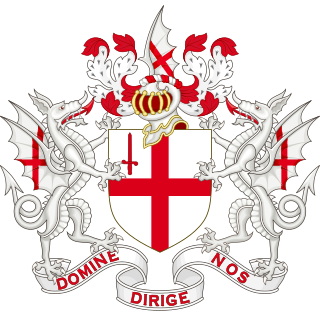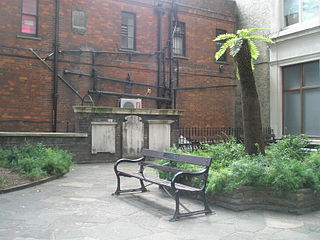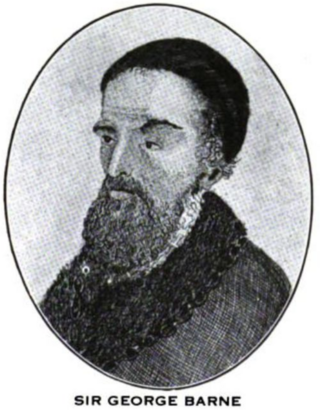Related Research Articles

The City of London Corporation, officially and legally the Mayor and Commonalty and Citizens of the City of London, is the municipal governing body of the City of London, the historic centre of London and the location of much of the United Kingdom's financial sector.

The Worshipful Company of Mercers is the premier Livery Company of the City of London and ranks first in the order of precedence of the Companies. It is the first of the Great Twelve City Livery Companies.

The mayor of St. Louis is the chief executive officer of St. Louis's city government. The mayor has a duty to enforce city ordinances and the power to either approve or veto city ordinances passed by the Board of Aldermen. The current mayor is Tishaura Jones, who took office on April 20, 2021.
Sir Thomas Bloodworth, born Blidward, also spelt Bludworth was an English merchant and politician who sat in the House of Commons from 1660 to 1679. He was Lord Mayor of London from October 1665 to October 1666 and his inaction during the early stages of the Great Fire of London was widely criticised as one of the causes of the great extent of the damage to the city.
Two sheriffs are elected annually for the City of London by the Liverymen of the City livery companies. Today's sheriffs have only nominal duties, but the historical officeholders had important judicial responsibilities. They have attended the justices at the Central Criminal Court, Old Bailey, since its original role as the court for the City and Middlesex.

Farringdon Without is the most westerly Ward of the City of London, England. Its suffix Without reflects its origin as lying beyond the City's former defensive walls. It was first established in 1394 to administer the suburbs west of Ludgate and Newgate, and also around West Smithfield. This was achieved by splitting the very large, pre-existing Farringdon Ward into two parts, Farringdon Within and Farringdon Without. The large and prosperous extramural suburb of Farringdon Without has been described as having been London's first West End.

St Peter, Westcheap, also called "St Peter Cheap", "St Peter at the Cross in Cheap", or "Ecclesia S. Petri de Wodestreet", was a parish and parish church of medieval origins in the City of London. The church stood at the south-west corner of Wood Street where it opens onto Cheapside, directly facing the old Cheapside Cross. In its heyday it was a familiar landmark where the City waits used to stand on the roof and play as the great processions went past. It was destroyed in the Great Fire of London in 1666, together with most of its surroundings, and was never rebuilt.
Sir John Shaa or Shaw was a London goldsmith. He served as engraver and later joint Master of the Mint, and as Sheriff and Lord Mayor of London. While Lord Mayor he entertained ambassadors from Scotland, and was among those who welcomed Catherine of Aragon to England. He is mentioned in a poem by William Dunbar.
Sir William Browne served as Master of the Worshipful Company of Mercers from 1507 to 1514, and as alderman, auditor, Sheriff and Lord Mayor of London. He died in office on 3 June 1514 while serving his term as Lord Mayor.
Adam de Basing was a 13th-century English politician and Mayor of London. The scion of a London political family, he was the son of alderman Peter Basing and grandson of an earlier mayor, Salomon de Basing. Adam was a draper who supplied the household of Henry III, for which he was rewarded with several pieces of property in the Bassishaw and Milk Street areas. He served as sheriff in 1243/1244, alderman from 1247 - 1260, and mayor in 1251/1252. He married a woman named Desiderata and they had at least one son, Thomas de Basing, who entered the wool trade but died young. Another of their children, Joan, married Henry le Walleis, who would later serve five terms as mayor of London. Basinghall Street in London is named after his family.
Henry le Walleis was a 13th-century English politician and Mayor of London. His origins are obscure; he was an outsider to London and may have been Welsh by birth. After making his fortune in the wine trade, he became an alderman in 1269 and sheriff in 1270. As alderman, he represented the ward of Cordwainer. He went on to serve five terms as mayor.
Nicholas de Farndone was a 14th-century English goldsmith and politician who served four non-consecutive terms as Mayor of London.
Andrew Aubrey was an English merchant and politician, who served three terms as Lord Mayor of London during the reign of Edward III.

John Fresshe was a citizen, alderman, and Mayor of London in the latter years of the fourteenth century. A merchant by trade, he was a member of the Mercers' Company, a medieval London trade guild, and has been described as one of London's "leading citizens at the end of the century".
Sir John Woodcock was an English merchant and politician. He held several offices over the course of his life, including Lord Mayor of London, and exercised considerable influence during the reigns of both Richard II and Henry IV. One of the richest Londoners of his time, he lent large sums to both those rulers.
John Hende was an English merchant and politician who served twice as Lord Mayor of London. He was imprisoned on the orders of King Richard II, before later becoming a leading financier of the reign of King Henry IV after Richard's overthrow.

Sir George Barne was an English businessman in the City of London who was active in developing new trading links with Russia, West Africa and North America, far outside what had been traditional English trading patterns. Created a knight in 1553, he served as Sheriff of London and Lord Mayor of London. He was the father of Sir George Barne and grandfather of Sir William Barne. Nicholas Culverwell was probably a nephew.
Hamo de Chigwell was an English merchant and politician. He served seven terms as Lord Mayor of London, between 1319 and 1327. He was a controversial figure, described by a contemporary alderman as "the vilest worm that had been in the City for more than twenty years", and played a role in the struggle for power between King Edward II and Queen Isabella.
References
- ↑ "Lord Mayors of the City of London from 1189" (PDF). www.citybridgetrust.gov.uk. Archived from the original (PDF) on 14 July 2014. Retrieved 9 June 2014.
- ↑ Besant, Sir Walter "Medieval London" pp. 51 - 54
- ↑ Loftie, William John "A History of London" pp. 173 - 177
- ↑ Williams, Gwyn A. "Medieval London" pp. 245 - 246